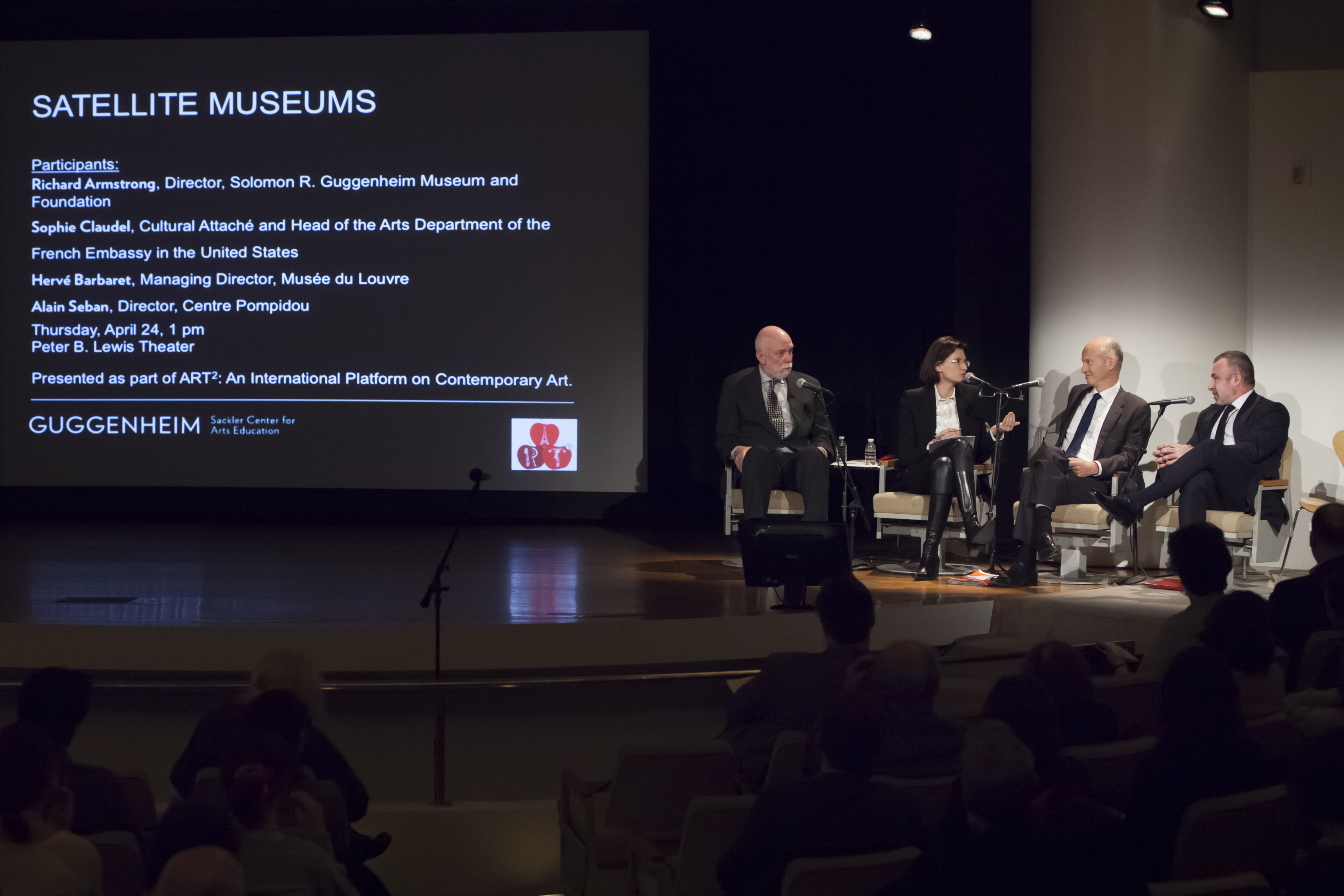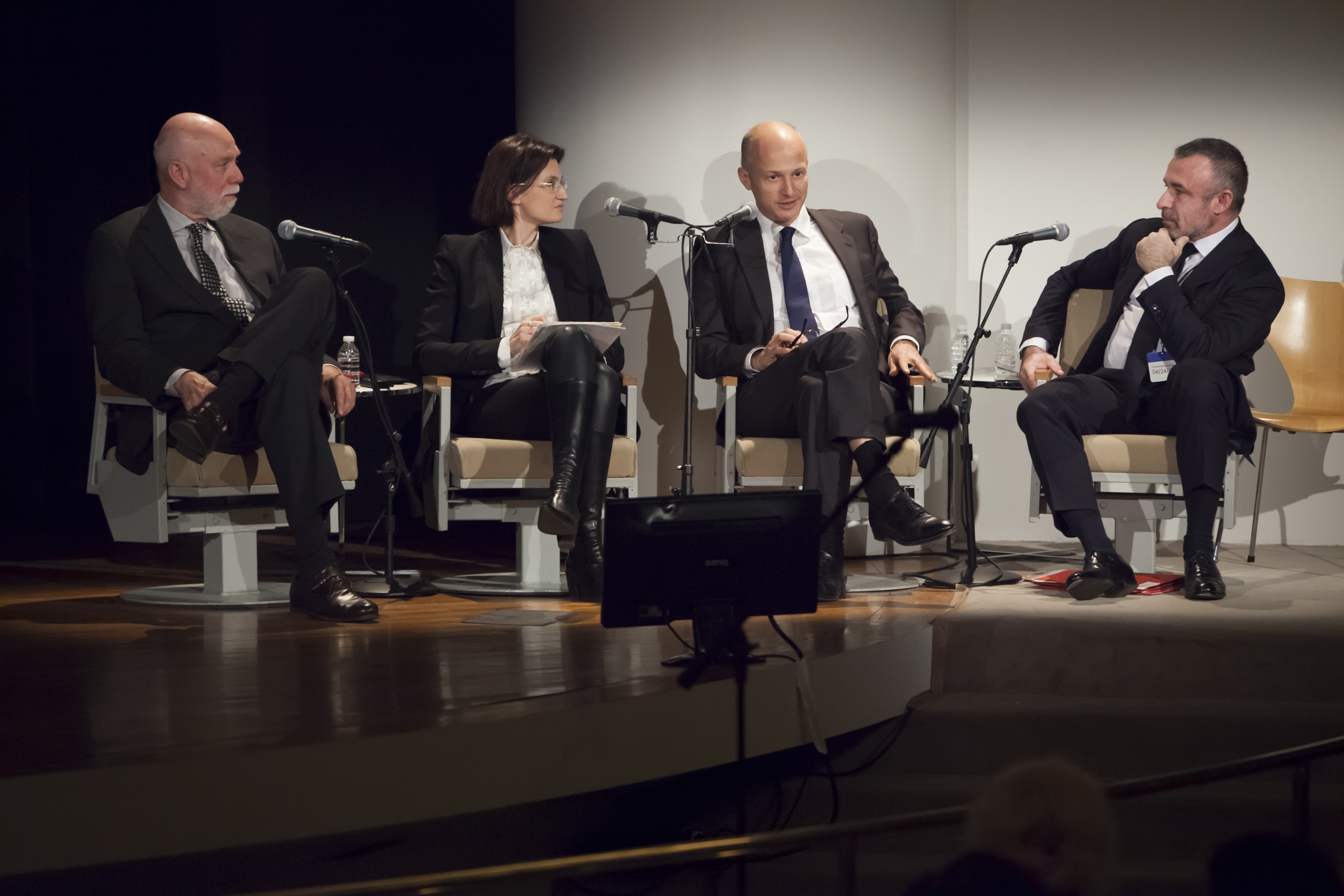by: cmgdkrb
As part of its superbly meandering ART² detour into questions about “Museums Today,” the Arts Department of the French Embassy has been organizing important debates on the cultural identity of museums in the 21st century. Presented in collaboration with the Institut français, the French Ministry of Culture and Communication, and FACE (French American Cultural Exchange), the month-long visual arts festival has been exploring ideas and themes paramount to the international art world, working with 42 partner museums, galleries, universities, and non-profit spaces through the month of April. The endeavor was conceived as a French-American exchange of views centered on issues that drive museums and private foundations alike. Topics of discussion during the Museums Today program included exhibiting collections, new perspectives on art history, the production of contemporary art and opening of satellite museums in an effort to globalize a museum’s presence. Programs have taken place at the Judd Foundation (winner of a 2014 AIANY Design Award), the French Embassy, MoMA and the Guggenheim Museum.
At the Guggenheim’s newly renovated Peter B. Lewis Theater, Sophie Claudel, the French Embassy’s cultural attaché and head of its Arts Department, moderated a panel discussion on satellite museums that included the directors of three major museums building and operating facilities far from their home base. Richard Armstrong, director of the Solomon R. Guggenheim Museum, spoke about the Bilbao Effect and how it has changed notions throughout the museum world about global outreach and collection accessibility. Armstrong, who has served as the Guggenheim’s chief since November of 2008, preferred the word “constellation” over “satellites” when describing the relation of different components of the Guggenheim. He also spoke of being “transnational” rather than “universal” in appeal. Talking about how to attract contributors and sponsors, he contrasted the National Gallery’s recent “takeover” of the Corcoran Gallery, across the street from the AIA’s headquarters building in Washington, DC, saying that the Guggenheim “would go to another city in America only if it were utterly irresistible.”
Alain Seban, director of the Centre Pompidou, echoed the internationalist perspective saying that “contemporary art is global, so the new museum has to go global, creating connections.” Seban has been the chairman, director, and CEO of the Centre Pompidou since 2007, and has a background in administrative law and communications, having been in charge of writing France’s legislation regarding all media activity and supervising the public broadcasting system. In regard to the branding of cultural activity through invitations to international museums such as the Centre Pompidou, he said that it depended on context, with “a country like China needing to build its own brand in regard to contemporary art,” rather than importing the works of another place.
Musée du Louvre Managing Director Hervé Barbaret agreed that a satellite museum “has to be anchored in the place where it is located so as not to be seen as something completely from outside.” He spoke of how “art is something that is shared by everybody, something that has no social boundaries.” In Paris, Barbaret said, the collections of the Louvre end with work from the middle of the 19th century, whereas in satellites there can be more inclusion of contemporary art, consequently creating “a dialogue with a past, a dialogue between generations.”
Centre Pompidou: Satellite museums are a way to gain exhibition space because it can’t expand anymore in Paris. It holds temporary exhibitions to show some artworks from the collection. It created traveling structures, namely ephemeral museums, to exhibit those artworks with the idea of a “nomad” museum that is touring across the country. One of these “pop-ups” is going to open in Malaga, Spain, in 2015, showing collection masterpieces such as works by Picasso. It’s a way to show the “best” to people who generally don’t have access to art. In Metz, they wanted to reach different audiences and communities, mainly local residents. The global museum can make connections with local artists and institutions, and also improve expertise in managing the museum’s collection. It is also a way to get a new angle on presenting the collection.
Guggenheim: It already has numerous satellite museums (Bilbao, Venice, Berlin, Mumbai, etc.). Richard Armstrong prefers the calling them “constellation museums.” The aim is to get broader representation in different cultures and parts of the world. It is also an opportunity to develop new ideas about art everywhere in the world. The Guggenheim is a “global institution.” The “Bilbao effect” was a success in boosting the economy of the area; it was a mutual benefit for both the museum and the city. It plans to open another museum in Helsinki, and one is being built in Abu Dhabi that will be 21 times larger than the Guggenheim in New York.
Louvre: The museum has been sharing its collection since 1968, with some artworks shown in Avignon, so sharing the collection is an old idea. In Abu Dhabi, however, it is a new concept – it just gave the name, like a trademark, and wants the Arab Emirates to create its own collection. The Louvre supports and shares more than just a name. They share founding values, namely universality and humanism. It would be the UAE’s own “universal museum.” The Louvre wants also to put forward the educational/social and scientific elements – its technological achievements. Indeed, there is a contrast with what they have done in Lens, which is considered a “poor” area, where the museum was seen by local governments as a chance to boost the economy (similar to the Guggenheim in Bilbao). They share a part of the permanent collection as well as temporary exhibitions.
During the Q&A there was much discussion about the ethical responsibility of museums to assure decent working conditions, safety standards and salaries of construction workers and others involved with the projects, particularly in places with different cultural assumptions. The concluding question, however, was about the degree to which architecture defines the cultural identity of satellite museums, linking them both to the home base and the traditions of remote locations.
Armstrong noted the reliance of cultural institutions, including the Guggenheim, on cutting-edge design by well-known architects such as Frank Gehry, FAIA, in Bilbao. He said that in New York, “when the Guggenheim was built, it can be said that Frank Lloyd Wright was not necessarily thinking first of the art that would be displayed here, but to some degree about the intersection of contemporary architecture with artworks. Museums need to reflect the best contemporary architecture of the day.” The facility renovation effort involving former AIANY Board Member Megan Chusid, AIA, demonstrates the continuity of that tradition.
For Seban, architecture is not currently the issue. He said that unlike other major museums, the Centre national d’art et de culture Georges Pompidou has no “iconic works that draw museum-goers in to the building.” He noted: “At our museum, visitors can enter the building without seeing any of the collection. That is not the case at the Guggenheim or the Louvre. At the Louvre, 85% of visitors see one or more of three iconic works, the Mona Lisa, the Venus de Milo, and the Winged Victory of Samothrace. We don’t have anything like that in our collection; therefore we need to spend more time and effort on our collection rather than our architecture.”
But Barbaret countered that “the architecture of the museum is the first work of art that you see as you enter. It has to be impressionnant, translated as intimidating – and modest at the same time. The genius of the architect is to be able to mix together these two different objectives at the same time.”
The dialogue between the three museum directors was very interesting, especially since the institutions are so different from each other. It might have been interesting to have heard them go in to more depth about the reasons to have selected Abu Dhabi to construct such satellite museums. The architecture, of course, is amazing. One can hope, as they all said, that the museums will serve as a point of departure for bringing democracy to this part of the world and not just a golden screen to hide misery and injustice.
The idea of “satellite” vs. “constellation,” discussed during the panel, seems very relevant regarding the various types of relationships that exist between historical museums and their creations. For the Guggenheim, the principle of “constellation” is quite strong, since all Guggenheim locations share common symbolic and rational attributes (name, logotype, iconic architecture, and website). Each has a specific functional and legal licensing agreement with local governments. To quote marketers, the Guggenheim identity is an “umbrella” that covers all the fieldwork – however, it permits or even promotes differences. Bilbao certainly does not have the same cultural identity (and image, in the public’s mind) as New York or Venice.
On the contrary, many museums develop new spaces as “satellites.” They extend their identity and reach new public, rather than offer variations of their identity. In public perceptions, these museums are considered as “offspring,” belonging to the institution. At least in the first years or decades, the satellites’ identity directly depends on the historical museum – without the Louvre and Centre Pompidou in Paris, Pompidou Metz and Louvre Abu Dhabi would not have any significant meaning on their own. Their identity is first built on the idea of an extension (and imitation) of their parent. However, to become more than a “satellite,” and to attract people thanks to their own collections and programming, they have to go beyond the mere reference to the Louvre and Centre Pompidou and develop a specific cultural identity. That is, to quote Paul Ricoeur, satellites need to go beyond an identity-idem (permanence, imitation), and build their identity-ipse (ipséité or “selfhood”).
Sophie Claudel, who, since 2001, has also led the Arts Mediation Program of the Fondation de France, Nouveaux Commanditaires, a unique initiative for community conflict resolution, brought consensus to the program by closing on the upbeat note of the importance of these satellite installations in expanding access to culture. She said, “The issue of a ‘global’ museum for a local audience and/or a ‘local’ museum for a global audience is the real question that these satellite museums will have to answer in the years to come. I think that it is this articulation which will be essential.”
Clémence Mailly is a masters student of museology from Montreal.
Gwenaёlle de Kerret is a Sorbonne-based semiologist who also works at Harris Interactive.









